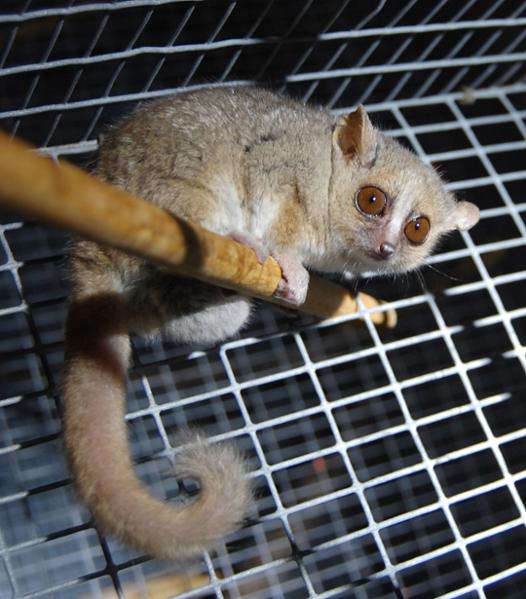
Mouse lemur: a little wonder of nature!
Mouse lemurs, of the genus microcebus, are the smallest lemur species in the world and therefore the smallest primates in the world as well. They are about 12 cm long with a tail of about 15 cm.
These animals are so difficult to spot in the forest and to study that new species are still being discovered. Their biological and genetic characteristics never cease to amaze and they may be the key to new scientific developments!
However, these tiny lemurs are in danger of extinction since their habitat is gradually deteriorating due to human activity. Let’s get to know this little wonder of nature, endemic to Madagascar!
A primate the size of a mouse!
Mouse lemurs weigh no more than 90 g and are the size of a large mouse. They have large eyes with hypersensitive retinas. Their ears (sizes depending on the species) are also very sensitive, allowing them to hear a prey from several meters away. These are insects, but “microprimates” also feed on fruit, nectar and honey. They isolate themselves when feeding!
They are nocturnal, which makes it even more difficult to observe them. During the day, they sleep in small groups (males sleep alone) in tree hollows or leaf nests. These groups consist of about 15 individuals on an area of 700 m² to 2 ha.
Mouse lemurs mark their territory by urinating on their hands and feet, dispersing the smell as they move. The breeding season is between September and October and the babies (2 to 4 per female) are born in November or December after 59 to 62 days of gestation. Males are rarely aggressive, except when they are in captivity.
What is more amazing is that they belong to primates despite their small size! Scientists study them for discoveries that could be applied to humans. In particular, mouse lemurs can enter a state of “torpor”, a form of dormancy.
A primate that hibernates (or almost)!
These tiny lemurs have a greasy tail, a way to store energy and use it during periods of food shortage related to change of season, especially in winter (dry season in Madagascar). However, they do not overwinter, as they do not stay in this state of torpor long enough.
They curl up and lower their metabolic rate (reducing their body temperature to a minimum of 7°C) to save their energy. They can voluntarily raise their body temperature when they emerge to hunt for food.
The dormancy period depends on the animal’s habitat and sex. In particular, females experience several weeks to 5 months of torpor in the Kirindy forest (southwestern Madagascar). Males never sleep more than a few days and always wake up before females to establish a dominance hierarchy.
Species still to be discovered?
The most common Microcebus species are the reddish-gray mouse lemur, Microcebus griseorufus (in the northern and western dry deciduous forests and in the southern thorny bushes) and the brown mouse lemur, Microcebus rufus (in the eastern humid and dense forest).
The genus microcebus includes 24 species, the most well-known being grouped as follows:
In the northwest of Madagascar:
· Danfoss’ mouse lemur – Microcebus danfossi
· Bongolava mouse lemur – Microcebus bongolavensis
· Lokobe mouse lemur – Microcebus lokobensis (LokobeReserve)
· Claire’s mouse lemur – Microcebus mamiratra (Lokobe Reserve)
· Ravelobe mouse lemur – Microcebus ravelobensis (forest near Lake Ravelobe)
· Northern brown mouse lemur – Microcebus tavaratra (Ankarana Special Reserve)
In the northeast and east:
· Mittermeier’s mouse lemur – Microcebus mittermeieri
· Sambirano mouse lemur – Microcebus sambiranensis
· Simmon’s mouse lemur, Microcebus simmonsi
· Goodman’s mouse lemur (Andasibe-Mantadia National Park)
In the south:
· Jolly’s mouse lemur – Microcebus jollyae
· Madame Berthe’s mouse lemur – Microcebus berthae (Kirindy forest)
Three new species were discovered in 2016:
· Ganzhorn’s mouse lemur (microcebus ganzhorni), discovered in southeast Madagascar
· Manitatra mouse lemur, from western Madagascar
· Boraha mouse lemur, named after the animal’s island of origin, Sainte-Marie or Nosy Boraha in Malagasy
Endangered species or not?
Mouse lemurs’ main predators are birds of prey and large snakes, but this is completely natural. Baby lemurs will survive, unless man completely destroys his habitat.
Gerp’s mouse lemur is a critically endangered species in eastern Madagascar. The Gerpi project, carried out in Anjahamana, Andobo, Sahafiana and north of Anivorano Est, aims to conserve this species.
It could be said that all projects for the management and conservation of a protected area housing mouse lemurs contribute to their preservation. If the threat was only climatic, mouse lemurs would have faced it thanks to its great adaptive capacity!
Naturalists speculate that mouse lemurs are the most ancient surviving form of primates, but some believe that this genus of lemur has evolved into dwarfism because of its isolated habitat. Madagascar is in particular a quasi-continent! In any case, mouse lemurs are impressive!

